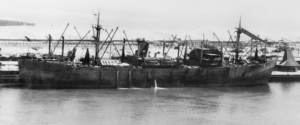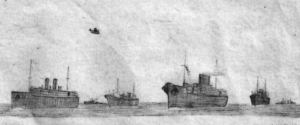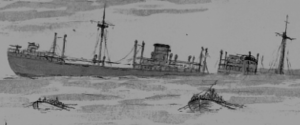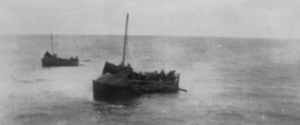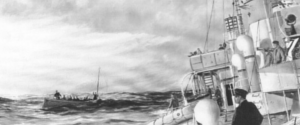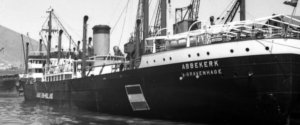1200 mile south of Java: Beggars can’t be choosers.

More than ever I realized that working in the engine room during wartime one never got used to the fact that you could hear or see nothing of what was happening outside. Particularly if you were aware that not too far away somebody could be ready to push a button to release a bomb, torpedo or grenade at your ship. After one’s watch going topside you could still be blown up every second during the day or night. Nevertheless I was happy every time I finished my watch. It was difficult to be happy thinking about our cargo; I thought everybody was of the same opinion.
Adriaan Kik, ass. engineer on Abbekerk
Abbekerks bridge and crowded foredeck seen from the bow. Picture by Captain James E. Crane, flight Surgeon FEAF (Thanks to Jim Crane)
We had no other hair-raising events, though we did of course hear the routine swill-pail rumors that went around the ship every day about being chased by submarines and so forth. The weather became extremely cold. I remember how hard it was to keep warm even with a flying suit on, sleeping up on the deck and wrapped in one thin blanket. The rain storms were frequent. They would soak us and all our belongings. Some nights it was so cold that I found it impossible to sleep. It was necessary to get up and walk about to keep warm.
Flight surgeon Captain James E. Crane, Far East Air Force
It was during this time that a group of us was sitting on deck up near the bow. As the swells grew in size, the bow would go up a little higher each time. We wondered if it would eventually go high enough that we would see the horizon behind us over the top of the ship’s mast. Bets were laid. We watched, and waited. Sure enough, the horizon would come up a bit higher each time the bow dipped then rose. Now we could see the horizon over the bridge. It started up the mast, as the sea got rougher. Finally, the bow came up so high we could see the horizon over the top of the mast. But when the bow dropped into the trough, it was at such a steep angle that a huge wave came crashing over the bow. We got our shower for the day, and we were almost washed overboard in the process.
Corporal Bill Heath, HQ Far East Air Force
March 3, 1942. Sea was even rougher this morning, and one could hardly stand on deck. The air was almost cold. The men had been breaking into cases of clothing in one of the holds to obtain heavier clothing. Leather flight jackets started showing up all over the ship, as were beards. It wasn’t pleasant shaving in cold sea water. However expecting to land the following day, some gritted their teeth, shaved and cleaned up a bit. No one complained because all knew we were lucky to be alive.
Corporal Bill Heath, HQ Far East Air Force

ms Sloterdyk arrived at Tjiltjap with a cargo of planes and ammunition on March 1. She left with the planes still on board and would arrive safely at Fremantle
Leaving Tjilatjap on March 2:
- Generaal Verspijek (1213 brt)
- Duijmear van Twist (1030 brt)
- Kota Baroe (7307 brt)
- Sloterdijk (9227 brt)
- Tsingsang
- Tjisoera (7089 brt)
Losses (merchant ships only) 2 March De Klerk (Dutch): The cargo ship was scuttled at Tandjong Priok, Netherlands East Indies, to prevent capture. Raised, repaired and put in Japanese service as Imaji Maru. Kasuaris (Dutch): The tanker was scuttled off Surabaya, Dutch East Indies to avoid capture by Japanese forces. Crew rescued by Inazuma Imperial Japanese Navy). Proteus (Norway): The cargo ship was scuttled at Batavia, Dutch East Indies. Speelman (Dutch): The passenger ship was scuttled at Surabaya, Netherlands East Indies, to prevent capture. Raised, repaired and put in Japanese service as Hakko Maru. Talang Akar (Dutch): The tanker was scuttled at Surabaja to prevent capture. Salvaged and put in Japanese service as Tango Maru. Toendjoek (Dutch): The cargo ship was scuttled at Tandjung Priok as a blockship. Salvaged and put in Japanese service as Tango Maru. Tunni (Norway): The cargo ship was scuttled at Surabaya, Netherlands East Indies. Sina Bang (Dutch): The cargo ship was sunk by aircraft based on Japanese aircraft carrier RyūjŠ.
3 March Bintoehan (Dutch): The cargo ship was scuttled south of Java, Netherlands East Indies to prevent her capture by Arashi. Koolama (Dutch): The passenger ship was bombed and sunk south west of Dutch Timor, Netherlands East Indies by Japanese aircraft. Siantar (Dutch): The cargo ship was shelled, torpedoed and sunk in the Indian Ocean 250 miles north west of Shark Bay, Australia by submarine I-1 . 37 survivors were rescued by Van Spilbergen. 21 crewmen were killed. Van Waerwijck (Dutch): The cargo ship was scuttled at Tandjong Priok, Netherlands East Indies. Raised, repaired, and put in Japanese service as Hirukiku Maru.
Source:
- https://en.wikipedia.org/wiki/List_of_shipwrecks_in_February_1942
- "De Nederlandse Koopvaardij in de Tweede Wereldoorlog" by L.L. von Münching

